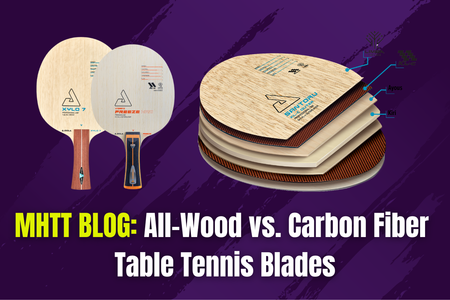
All-Wood vs Carbon Table Tennis Blades | MHTT Blog
This is probably one of the most common topics when it comes to table tennis blades, the comparisons and benefits of All-Wood vs Carbon blades. Let’s take a look at some of the advantages and disadvantages of Wood blades and Carbon blades:
The Advantages of All-Wood Blades:
- High levels of control
- Good for spin production and feeling
- Lower cost
- High dwell times and contact quality
- More durable and long lasting
- Less variables to consider when choosing
The Disadvantages of All-Wood Blades:
- Doesn’t offer the same power output as carbon and other fibers
- Many all wood blades have more vibration through contact
- Less precision and stroke feedback than fiber blades
- The sport is becoming more physical and more aggressive, all-wood often lacks the sharpness in ball contact for the modern game at high levels.
- Very little innovation, more classic options
All-wood blades are a classic mainstay in the sport of table tennis, but as time has gone on the carbon fiber blade has taken center stage as a more popular choice for many table tennis players. There are still multiple gears based on wood types and ply count, for example a 5-ply with hinoki top layer like the Xylo 5 blade offers more touch and control, whereas the Xylo 7 blade has more contact stiffness and speed.
While all-wood composites are great for developing players and those who wish to play a more controlled all-round or offensive game – the sport is changing and the need for more speed and acceleration at the higher levels is crucial, hence the evolution of table tennis equipment.
Who are All-Wood Blades Best Suited To?:
- Beginners learning basic strokes
- Recreational social players
- Players with a more all-round play style
- Players who like the feel of an all-wood blades
- Those who prefer a spin oriented control game and a softer feeling blade
There is still very much a place for the all-wood blade, and it will probably be a part of the sport for many, many years to come. Let’s take a look more at the composite fiber blades.
The Advantages of Carbon Fiber Blades:
- More spin and power from flex and stiffness
- Lighter options, carbon layers are very thin
- Good range of soft and stiff carbon blades
- Different types of carbon to suit different styles i.e ARY-c, KL-c, PBO-c, 3K-c
- Higher level of precision and stroke feedback
- Less vibration in carbon fiber blades
- More innovation for better performance
The Disadvantages of Carbon Fiber Blades:
- Large differences in feel and performance between different composite combinations
- More variables which can make finding a blade you like harder
- Higher cost than all-wood blades
- Lower durability than all-wood blades due to carbon layers being thinner and more fragile
- More speed means less control in some of the stiffer blades
Carbon Fiber table tennis blades offer the next level of high performance, the majority of aggressive players in today’s modern game are using some kind of fiber composite – rather than an all-wood blade.
As blade innovation has improved, there is a greater range of carbon rackets, including softer alternatives which bridge the gap between the high end stiff and fast carbon fiber rackets and the all-wood control and feeling options. Carbon fibers and inner layer alternatives with softer woods like limba and hinoki are a great option for those transitioning from all-wood to carbon, and those (like me) who want to try and capture the best of both worlds. There are also great new innovations in the world of composite fibers like JOOLA's unique X3 weave, which combines two types of carbon composite in opposite directions - this is the signature carbon layer of the Premium JOOLA Vyzaryz Trinity Blade.
Who are Carbon Fiber Blades Best Suited To?:
- Recreational players who are competitive (there are high end recreational carbon rackets)
- Players who are developing into active competition players
- Players developing higher level techniques
- Those who have a more aggressive playing style and require more power
- Players who like the feel of harder, faster blades
While the majority of table tennis players will start out their careers with an all-wood blade, eventually most of those players will transition to a carbon fiber blade. As the game becomes more physical and higher pace, this trend is likely to continue and grow as more innovative composites and designs enter the picture.
One of the things that is most important when choosing a blade is to make sure you stay true to your game, sometimes you can change to a faster or slower blade and you adapt your game to suit the equipment and make negative changes, this is something to be conscious of. It is also worth noting that (in my experience) it can be very difficult to go back to using an all-wood blade after using carbon fiber for many years.
Of course there are plenty of other factors to consider like wood types, carbon types and all the rest, but hopefully this gives you some insight into these two different categories of table tennis blades, and which might be better suited for you!




